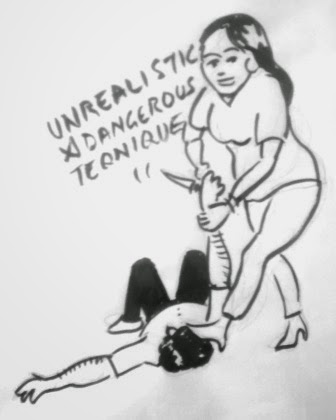Any martial art is good, if the instructor is NOT bad
In my recent blog I criticized the technique of a guy in Chennai, who
claims he is a martial arts teacher . He also wrote a rejoinder, which without
mentioning the art by name, criticized every aspect of KravMaga. This guy was also intelligent enough to make his prejudiced bile sound
like a dispassionate comparison of martial arts. But ...
... Why is it NOT intelligent to compare different martial
arts?
This half-baked guru's comparison of different methods itself is misleading, like comparing apples and oranges, to use a cliché.
This half-baked guru's comparison of different methods itself is misleading, like comparing apples and oranges, to use a cliché.
- What he missed to understand was the fact that every method is different, because they evolved in different environments, and for different objectives.
- When analyzing any particular fighting art one has to look at the anthropological, sociological and sometimes even the political aspects of the environment in which that art evolved.
- Another major differentiator in a method of fighting is, for what job-profile it is designed for. I will extrapolate this a bit more.
Let me first state that the concept of sub-species amongst humans is NOT racist.
For instance in forensics , when examining a murder crime, whether the
body is of an African, Asian or European ancestry can be specified with a high
degree of accuracy.
So, it's an established reality that subspecies of humans have some predominantly common physical characteristics.
So, it's an established reality that subspecies of humans have some predominantly common physical characteristics.
 |
| Is this race only for blacks?! |
The martial art evolved in a region where mostly the men are tall and big will
be different from a region where the majority of the males are short and
stocky. That’s why different geographies gave us varied forms like Boxing,
Judo, KungFu, Kali and Wrestling.
Why look into sociological origins of a martial art?
The origins of traditional Japanese unarmed combat can be traced to the caste system which prohibited certain communities from carrying weapons. In India too there was a similar caste system, where the Kshatriyas were supposed to be the warrior class.
Nowadays these caste differentiators have blurred; so thankfully martial arts can be learnt by everyone.
The threats to the community also influenced the martial traditions; the most legendary, I can recall now, are the Spartans of ancient Greece, the Sikhs of Punjab and the Gurkhas of Nepal. Not to forget the Buddhist monks of Shaolin, who evolved an unique system suited to their lifestyle.
The nature of the environment will also influence the fighting system..thats why a tribal in a tropical jungle will fight different from a Bedouin in the desert.
The origins of traditional Japanese unarmed combat can be traced to the caste system which prohibited certain communities from carrying weapons. In India too there was a similar caste system, where the Kshatriyas were supposed to be the warrior class.
Nowadays these caste differentiators have blurred; so thankfully martial arts can be learnt by everyone.
The threats to the community also influenced the martial traditions; the most legendary, I can recall now, are the Spartans of ancient Greece, the Sikhs of Punjab and the Gurkhas of Nepal. Not to forget the Buddhist monks of Shaolin, who evolved an unique system suited to their lifestyle.
The nature of the environment will also influence the fighting system..thats why a tribal in a tropical jungle will fight different from a Bedouin in the desert.
Why political climate influences a fighting art?
When carrying of weapons is banned by authority, mundane household or farm equipments evolve into improvised weapons. A classic example is the Tonfa of Japanese martial arts, which is the improvised version of the rice-grinder handle.
When carrying of weapons is banned by authority, mundane household or farm equipments evolve into improvised weapons. A classic example is the Tonfa of Japanese martial arts, which is the improvised version of the rice-grinder handle.
For more interesting information of improvised weapons, see here.
Since I teach prison guards, I come across lots of improvised weapons, like aluminium plates folded and sharpened into a crude knife. Even a tooth-brush can function as a knife if one end is sharpened!
Since I teach prison guards, I come across lots of improvised weapons, like aluminium plates folded and sharpened into a crude knife. Even a tooth-brush can function as a knife if one end is sharpened!
Why the trainee's profile influences the choice of fighting
methodology
- A policeman's job is different from a soldier's. A policeman is expected to control the aggressor, while a soldier is not.
- A hotel bouncer's job is different from a body guard's, even though both technically do third-party protection.
- A Man's problem is different from a Woman. His issue is Rage while hers is sexual harassment.
- A martial art suitable for a rule based ring fighter won’t be suitable for a wild street-fight.
- A technique which can be applied only by a seasoned Aikido practitioner, can't be taught to an average girl working in a bank.
The net take is - Any martial-art is good if the instructor
is NOT bad !
In my last post, I only analyzed the technique of this guy and not his system; if at all he has one! :)
Unfortunately he missed the essentials.
..................................................................................................
Similar posts -
In my last post, I only analyzed the technique of this guy and not his system; if at all he has one! :)
Unfortunately he missed the essentials.
..................................................................................................
Similar posts -
- 7 Dictums of what NOT to teach in self-defense for WOMEN
- The Tao of Fraud – or “How to find out if the martial-arts instructor is a martial-fart”
- 5 WAYS TO CHOOSE A STREET-SMART SELF-DEFENSE SYSTEM
- SMART STREET FIGHT - CLASSIC EXAMPLE
..................................................................................................
SreeRam is a KravMaga self-defence instructor at Chennai, South India. He teaches Civilians, Chennai City Police and Security.
SreeRam has started W.A.H.R (Women against harassment & Rape)an NGO devoted to increase personal safety awareness amongst women and equip them to handle sexual harassment at public and work places.
SreeRam conducts KravMaga personal safety and self-defense workshops at corporates, especially IT/BPO companies where many women work late. He has also conducted workshops, for rural women.
On 8th March 2012 ( International Women's Day) KravMaga SreeRam released a small handy booklet for women titled " 10A-s of Personal Safety for Women"
...............................................................
Mobile - 0-934 000 66 00 , Email - kravmaga.chennai@gmail.com
Chennai Site - https://sites.google.com/site/kravmagachennai/
KRAVMAGA BLOG - http://kravmaga-chennai.blogspot.com/
LINKED IN - http://in.linkedin.com/in/ksr960
FACEBOOK - http://bit.ly/KravMagaChennai
YOUTUBE - http://www.youtube.com/user/KravMagaSreeRam
GOOGLE PROFILE - http://www.google.com/profiles/ksr960
TWEET - @kravMagaSreeRam
SreeRam has started W.A.H.R (Women against harassment & Rape)an NGO devoted to increase personal safety awareness amongst women and equip them to handle sexual harassment at public and work places.
SreeRam conducts KravMaga personal safety and self-defense workshops at corporates, especially IT/BPO companies where many women work late. He has also conducted workshops, for rural women.
On 8th March 2012 ( International Women's Day) KravMaga SreeRam released a small handy booklet for women titled " 10A-s of Personal Safety for Women"
...............................................................
Mobile - 0-934 000 66 00 , Email - kravmaga.chennai@gmail.com
Chennai Site - https://sites.google.com/site/kravmagachennai/
KRAVMAGA BLOG - http://kravmaga-chennai.blogspot.com/
LINKED IN - http://in.linkedin.com/in/ksr960
FACEBOOK - http://bit.ly/KravMagaChennai
YOUTUBE - http://www.youtube.com/user/KravMagaSreeRam
GOOGLE PROFILE - http://www.google.com/profiles/ksr960
TWEET - @kravMagaSreeRam





Hi Sreeram,
ReplyDeleteYour analysis and inference is spot on. Every martial art (and i use the term broadly)across the world has evolved in response to the socio-political climate of a particular era and has then undergone a process of evolution that has either added new processes, techniques or fail-safes according to how it was perceived, intended, etc. Two classic examples exist, of which one is our very own Kalaripayattu, which is a true 'martial' art in every sense, as it honed skills that were meant for the battle-field. It uses a myriad weapons and has traditionally not been taught to women as it is a warrior's domain. The other is Capoeira, which was fighting skills disguised as dancing by black slaves who had to practice in secret to escape their Portuguese masters. It was a way to not only learn to fight, but to nurture their culture, music and traditions in one cocoon. Kalari has elements of self-defence, but is primarily is a fighting style based on aggression. Capoiera was designed primarily for slaves to defend themselves against their masters.
With respect to the efficacy of a martial art, yes virtually any martial art is good. However, I would like to take your arguement even further than your opinion than the fact that it depends on how good the teacher is. There is a great difference in having a martial artist who is technically very sound and one who can handle themselves in a fight. Both can be students of the same master. The difference is in application of the right tactics and techniques. In a real fight, the skill of the exponent is primary, not the style of martial art applied. Many people pointlessly argue which is the best martial art. The simple answer is that there is no 'best martial art'. The skill and the choice of tactics or techniques the exponent employs invariably decides the outcome. There are great kaaratekas and lousy karatekas, the same applies to boxing, taekwondo, aikido, etc. For example, Bruce Lee was deadly, but how many practioners of Jeet Kune Do exist that are anywhere near his caliber? Therefore, the skill of the instructor is vital, but ultimately the skill of the exponent in a given situation is the deciding factor.
Regards,
James